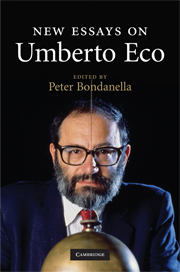Book contents
- Frontmatter
- Contents
- Notes on contributors
- Preface
- Acknowledgments
- 1 Eco and popular culture
- 2 Eco's semiotic theory
- 3 Eco's scientific imagination
- 4 From the Rose to the Flame: Ecos theory and fiction between the middle Ages and postmodernity
- 5 Eco's middle Ages and the historical novel
- 6 Eco and the tradition of the detective story
- 7 “The subject is in the adverbs.” The role of the subject in Eco's semiotics
- 8 Double coding memorabilia in The Mysterious Flame of Queen Loana
- 9 Eco and Joyce
- 10 Eco on film
- Selected bibliography on Eco
- Index
1 - Eco and popular culture
Published online by Cambridge University Press: 26 January 2010
- Frontmatter
- Contents
- Notes on contributors
- Preface
- Acknowledgments
- 1 Eco and popular culture
- 2 Eco's semiotic theory
- 3 Eco's scientific imagination
- 4 From the Rose to the Flame: Ecos theory and fiction between the middle Ages and postmodernity
- 5 Eco's middle Ages and the historical novel
- 6 Eco and the tradition of the detective story
- 7 “The subject is in the adverbs.” The role of the subject in Eco's semiotics
- 8 Double coding memorabilia in The Mysterious Flame of Queen Loana
- 9 Eco and Joyce
- 10 Eco on film
- Selected bibliography on Eco
- Index
Summary
Since the beginning of his long and most distinguished career, Umberto Eco has demonstrated an equal devotion to the high canon of western literature and to popular, mass-produced and mass-consumed, artifacts. within Eco's large corpus of published works, however, it is possible to chart different as well as evolving evaluations of the aesthetic merit of both popular and high cultural artifacts. Because such evaluations belong to a corpus that spans from the 1950s to the present, they necessarily reflect the larger epistemological changes that ensued when the resistance to commercialized mass culture on the part of an elitist, aristocratic strand of modern art theory gave way to a postmodernist blurring of the divide between different types of discourses. yet, it is also crucial to remember that, from his earlier publications onwards, Eco has approached the cultural field as a vast domain of symbolic production where high- and lowbrow arts not only coexist, but also are both complementary and sometimes interchangeable. This holistic understanding of the cultural field explains Eco's earlier praise of selected popular works amidst a plethora of negative evaluations, as well as his later fictional practice of citations and replays that shapes his work as best-selling novelist of The Name of the Rose (1980), followed by Foucault's Pendulum (1988), The Island of the Day Before (1994), Baudolino (2000), and The Mysterious Flame of Queen Loana (2004). Nevertheless, even in a type of writing that might appear as a capitulation to Kitsch art, Eco does not relinquish a desire to innovate upon the already said.
- Type
- Chapter
- Information
- New Essays on Umberto Eco , pp. 1 - 16Publisher: Cambridge University PressPrint publication year: 2009
- 3
- Cited by



